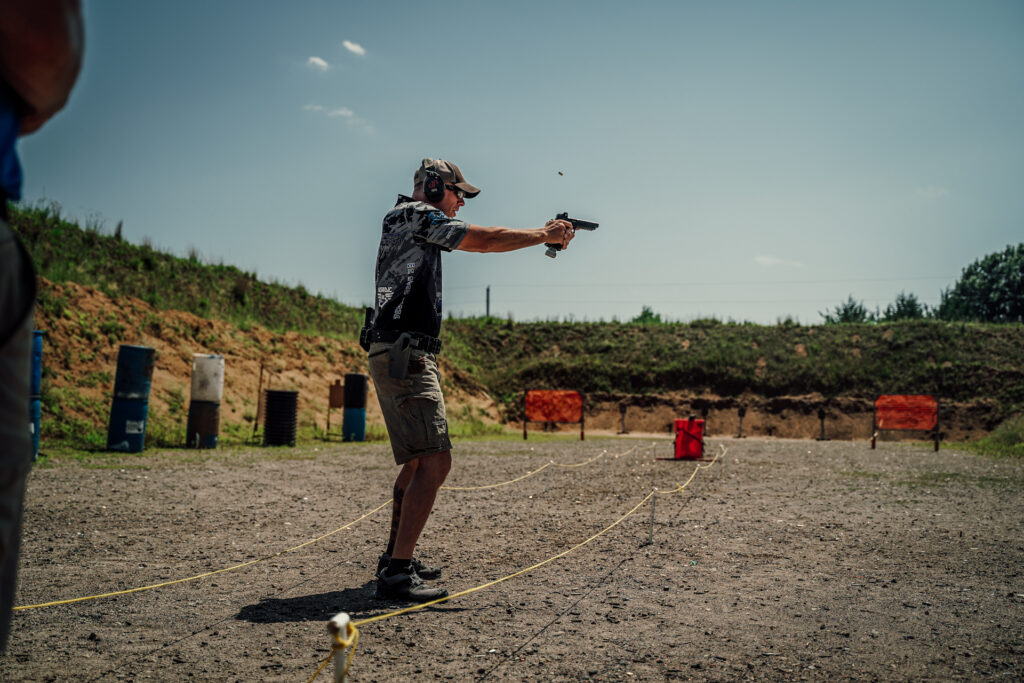
Pistol shooting is a pinnacle of marksmanship challenges. Handguns, being compact, are highly sensitive to technique errors. Yet, with a solid grasp of fundamentals and dedicated practice, shooters can significantly enhance their performance. This guide will cover the essential elements of pistol shooting, helping you improve your skills on the range or in competitions.
Mastering pistol shooting with consistent accuracy and speed is a significant challenge. The pistol’s unforgiving nature highlights any technique flaws. Yet, understanding the fundamentals and practicing discipline can lead to success.
The first fundamental is stance. A good stance is crucial for a consistent and reliable shooting platform. Here’s how to achieve it:
1. Foot positioning: Begin with your feet shoulder-width apart. Your strong-side foot should be about even with the mid-step of your weak-side foot.
2. Weight distribution: Keep your knees slightly bent and your weight on the balls of your feet.
3. Upper body posture: Maintain an upright chest and relaxed shoulders.
A proper stance ensures stability and allows for quick, controlled movements. It’s the base for all other shooting techniques.
A good grip is essential for managing recoil and maintaining accuracy. Here’s how to develop a strong, consistent grip:
1. Strong hand placement: Start by gripping the gun firmly while it’s in the holster. Hold as high on the grip as possible, with the back strap pressing into your thumb’s meat.
2. Thumb position: Keep your strong hand thumb relaxed but high enough for your weak hand to fit.
3. Weak hand integration: Fill the pistol’s opening with your weak hand’s thumb and heel.
4. Finger placement: Your weak hand’s fingers should wrap around the trigger guard, applying pressure on top of your strong hand’s fingers.
5. Weak hand thumb: Point it towards the target, resting along the pistol’s frame.
A proper grip manages recoil well without compromising accuracy. Mastering this balance greatly improves your shooting performance.
With a solid stance and grip, focus on sight alignment. This is critical for hitting your target:
1. Three planes of focus: On pistols with iron sights, focus on the rear sight, front sight, and target.
2. Front sight clarity: Ensure the front sight is clear in your vision for best accuracy.
3. Sight picture: Align the front sight inside the rear sight, with equal height and light on both sides.
4. Target alignment: Place this sight picture in the target’s center.
Remember, perfect sight alignment and a centered sight picture ensure your round hits the bullseye’s center. Consistent practice is key for accuracy – we’ve got another article that goes further in depth here.
Now, let’s focus on trigger control, a critical element for accurate shooting. Without proper trigger control, all other efforts can fail instantly.
Trigger control means pressing the trigger straight back without disturbing the sight alignment. Here are important points to remember:
1. Straight back pressure: Apply pressure straight back, avoiding side-to-side movement.
2. Smooth, consistent pull: The trigger pull should be smooth and consistent throughout.
3. Follow-through: Maintain trigger control even after the shot breaks.
4. Reset: Learn to feel the trigger reset for faster follow-up shots.
If the shooter introduces pressure to the trigger to the right or left, no matter how slight, it will cause the round to impact outside the center of the target. Mastering trigger control often makes the difference between good shooters and great ones.
While traditional dry fire practice is valuable, modern technology offers powerful tools to diagnose and improve trigger control. One such tool is the Mantis X system, a sensor-based training device that provides real-time feedback on your trigger pull.

Success with the pistol involves strict adherence to the fundamentals of stance, grip, sight alignment/sight picture, and trigger control. Repetitive training of these fundamentals is necessary to consistently achieve accuracy and recoil management for accurate follow-up shots.
Start your practice sessions by focusing on each fundamental individually. As you become more comfortable, begin to integrate them, always maintaining a focus on proper form. Dry fire practice at home can be invaluable for developing muscle memory without the cost of ammunition.
Once a shooter has built a strong foundation of reliable fundamentals, they can introduce speed and dynamic movement. This is where the real excitement of competitive shooting begins, but remember – even the fastest shooters rely on a rock-solid grasp of the basics.
Mastering pistol shooting is a journey that requires patience, dedication, and consistent practice. By focusing on the fundamentals outlined in this guide – stance, grip, sight alignment, and trigger control – you’ll build a solid foundation for success.
Remember, every world-class shooter started as a beginner. With time and effort, you too can achieve remarkable accuracy and speed with your pistol. Whether your goal is competitive success, personal defense, or simply enjoying the challenge of the sport, these fundamentals will serve you well.
Keep practicing, stay safe, and enjoy the rewarding journey of becoming a skilled pistol shooter!